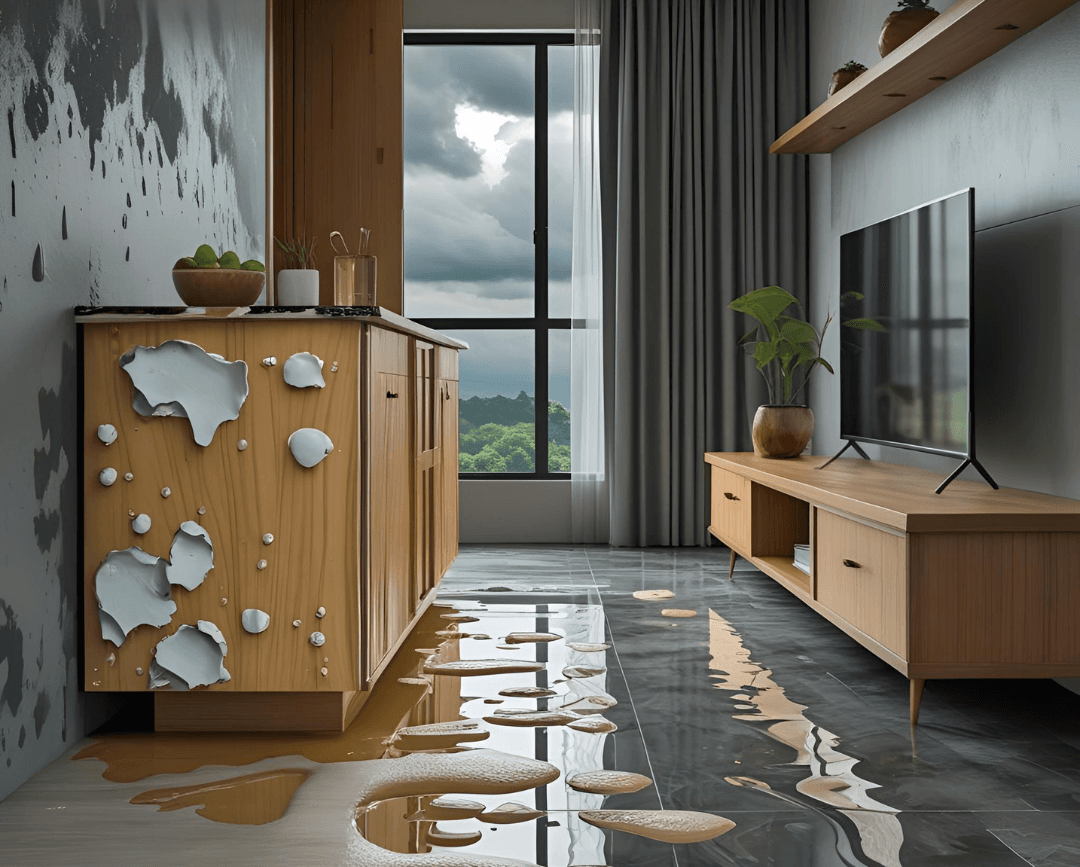
Common Monsoon Problems with Cheap Plywood and How to Solve Them

July 30, 2025
The monsoon season is better than the hot summer months, but while you're enjoying the breeze and greenery, your plywood furniture takes its leave from such relief. The most significant source of damage occurs during the rainy season, when dampness, high humidity, or water seeps into cheap plywood. If you've experienced swollen cabinet doors, mouldy wardrobes, or cabinets or bed panels changing shape or curving, this was likely due to the use of cheap plywood. This blog will cover common monsoon problems associated with low-grade plywood and how to avoid them with the range of premium, moisture-resistant plywood products that Royale Touche offers.
How Cheap Plywood Fails to Survive the Monsoon
While cheap plywood may appear to be an inexpensive option, it lacks essential properties that enable it to withstand the heavy rains during India's monsoon season. Cheap plywood has a core of low-quality timber and uses inexpensive adhesives to bond the wood, making it highly susceptible to damage due to exposure to moisture.
The banquet of problems includes:
-
Poor bonding strength due to cheap adhesives
-
Lack of waterproof treatment
-
Unseasoned or damp core material
-
No resistance to fungal growth or high humidity
This means that furniture made from cheap plywood starts to be damaged in the first few weeks of the Monsoon.
Common Problems with Low-Grade Plywood in Monsoon
Swollen Plywood
A common complaint during the monsoon season is that plywood starts to puff up, especially in corners and joints. This swelling also makes it difficult to open or close furniture, and spoils the appearance of the polished surfaces as well.
Delamination and Surface Peeling
When the adhesive in the plywood fails, the layers begin to break down, resulting in a process known as delamination. This usually accompanies surface veneer or laminate peeling and renders the furniture unusable or simply ugly.
Fungal and Mould Infestation
The high humidity associated with the rainy season encourages the growth of fungal and mould. Economic plywood lacks anti-fungal treatment and exhibits poor water resistance. If moisture enters from the outside, your cheap plywood will also absorb moisture inside. This leads to black patches on the underside lining and the surfaces. Mould infestation leads to a musty smell and hygiene concerns.
Bubbles in Laminates
If you notice air bubbles forming under the laminate surface, it becomes evident when moisture penetrates the plywood covering and disrupts the adhesive bond between the laminate and the plywood.
Ongoing Odour
In a wardrobe, kitchen cupboard, or drawer, there is a musty smell, which usually indicates consistent damp plywood. This also means your furniture is permanently damaged, structurally weak, and has microbial growth.
How to Further Protect Plywood from Getting Damaged by Monsoons
Even the best plywood can be better protected with a few common-sense precautions. Here is how you can protect your interiors and help your furniture last longer during the Monsoon.
Seal All Edges & Joints
The edges are where the most moisture will be absorbed. Make sure that your furniture edges are properly sealed with cartridge edge banding tape or laminated edge coverings. This should be done to block moisture from penetrating and sitting in the plywood core. Also, keep away from direct wall contact.
Avoid Wall Contact
Large furniture items, such as wardrobes or storage units, shouldn't be placed up against a wall! Whatever is going on with that wall, if it is an external or uninsulated wall, the dampness caused by monsoon weather can seep into a "solid" piece of plywood furniture. Ideally, do not place plywood furniture flush against walls. Retain a minimum of 1-inch air gap between the two surfaces.
Improve Airflow
Poor airflow can increase indoor humidity levels. Open windows when the rain stops, or use an exhaust fan when applicable (in kitchens and bathrooms). Good ventilation helps dry out trapped moisture caused by poor air circulation, reducing the chances of fungal growth.
Use Moisture Absorbers
Find the closest camphor balls, naphthalene balls, silica gel sachets, or charcoal briquettes and place them in furniture or storage items that remain closed. (e.g. wardrobe, drawer, shoe rack) These small products will absorb moisture and reduce the risk of mould and the dreaded odour.
Dry It Out Straight Away
If plywood becomes wet from spills, rain, or leaks, dry the furniture piece immediately by using a clean, absorbent cloth to wipe off the excess water from the surface. Time is not a friend to wet plywood, even if you bought and paid for waterproof plywood at a store.
Avoid Wet Cleaning
Wet mops or wet cloths should never be used to clean the surface of any plywood furniture. A dry microfiber cloth is often considered the best choice for cleaning any surface. Cleaning a surface with water can cause more damage to the plywood, as water slowly seeps into the plywood joints over time, causing the wood to swell or bubble, and potentially leading to surface peeling.
Take Time for Regular Maintenance
Check the furniture for moisture damage at least once a month during use, starting with the onset of the monsoon season. Applying a waterproof polish or lacquer once a year can add additional protection to plywood.
Lift Furniture Slightly Above the Floor
Plastic or rubber footings should be used beneath the legs of beds, cabinets, and tables to prevent damage. They protect against water from wet mopping or seepage from the floor itself, which often damages bottom panels first.
Royale Touche Plywood Choices to Make This Monsoon
As the monsoon sets in, your primary focus should be on having moisture-resistant plywood, engineered with this in mind. Royale Touche offers an award-winning range of high-performance plywood that provides exemplary protection against humidity, water, and temperature fluctuations.
Waterproof Plywood
Royale Touche Waterproof Plywood is designed for bedrooms, studies, and living rooms where the wood can experience some moisture. This will allow it to stand up above swelling and keep laminate bubbles away, and your interior looking good throughout the Monsoon and beyond.
Boiling Waterproof (BWP) Plywood
This is for the kitchens, especially the trolley, cabinetry under the sink, and bathroom furniture. It is designed to be fully waterproof and withstand extreme moisture. It will not delaminate or absorb foul odours because of its bonded structure, and it is properly laminated.
Marine Plywood
If you need heavy-duty plywood that is resistant to high exposure to water, this is it! It can be used on balcony furniture, window sills, storage exterior, or in high-humidity areas. Marine plywood stops fungal growth, will not warp, and is trusted in monsoon-affected areas.
Moisture Resistant (MR) Plywood
If you are looking for dependable plywood suitable for high-humidity areas, such as wardrobes, study tables, or bookshelves that will not be exposed to direct water, with MR, you have a cost-effective option that is monsoon-resistant. It has good resistance to air moisture, and will not allow deformation of furniture.
Make the Right Investment Today
You must not be uncertain about the rainy season deteriorating your structure and interior space. Using inexpensive materials for the core structure of your furniture or cabinetry, either for cost savings in the long run, will far exceed the benefits and still provide an unsatisfactory interior and lifespan for furniture or storage.
Choosing Royale Touche Plywood means the following:
-
Seasonal furniture stability and durability
-
Protection from moisture, fungus, and streaking/peeling of the surface
-
Long-lasting, beautiful qualities for every space
Don't let the Monsoon destroy your interiors. Be ahead of the game; if not now, plan. Be proactive and don't just assume people will care about quality. Royale Touche is your best.
Frequently Asked Questions
What's the best plywood for monsoons?
Marine and Boiling Waterproof (BWP) are the most recommended for the monsoon season, especially kitchens and bathrooms, as they better resist water, humidity, and fungal damage.
Can swollen plywood be mended?
If slightly, yes. It can be sanded down and resealed, but in most cases, the damage is irreversible. Doing it right with quality plywood is the better choice.
Why does plywood furniture stink during the rain?
Low-grade plywood absorbs moisture, which can lead to fungal growth that causes unpleasant smells. Use waterproof or MR plywood to prevent this.
Is moisture-resistant plywood suitable for use in the kitchen?
Only for dry zones, such as upper cabinets. In wet areas, while the cost is high, using Boiling Waterproof plywood will ensure that the protection lasts.
How to prevent mould from plywood furniture?
Using anti-fungal materials like Marine or BWP plywood, provide ventilation and use moisture-absorbing materials such as camphor or charcoal for enclosed spaces.
Related Blogs
How to Protect Your Plywood Furniture from Moisture During Monsoon Season
Best Plywood Solutions for Monsoon-Proof Home Interiors
